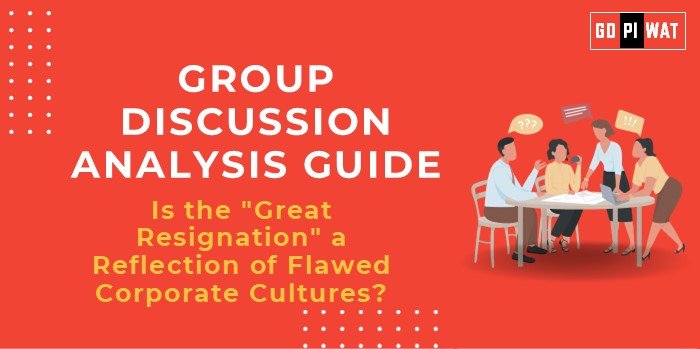📋 GD and WAT Analysis Guide: Is the “Great Resignation” a Reflection of Flawed Corporate Cultures?
🌐 Introduction to the “Great Resignation”
Opening Context: The “Great Resignation,” first observed in 2021, saw millions of employees voluntarily leaving their jobs, sparking global debates about workplace satisfaction and corporate ethics.
Topic Background: This phenomenon, catalyzed by the COVID-19 pandemic, revealed systemic dissatisfaction with corporate cultures, including inadequate work-life balance, insufficient wages, and a lack of personal growth opportunities.
📊 Quick Facts and Key Statistics
- 📉 Resignation Rate in the US: Over 50 million employees quit jobs in 2022—indicating a significant labor force upheaval.
- 🌍 Global Trend: 41% of employees globally considered quitting in 2023, per Microsoft’s Work Trend Index.
- ⚠️ Primary Reason: 64% cited toxic workplace culture as a key factor (MIT Sloan Review, 2023).
- 🖥️ Hybrid Work Effect: 62% of employees prefer flexible work models, highlighting a shift in workforce priorities (McKinsey, 2023).
🤝 Stakeholders and Their Roles
- 👥 Employees: Seeking mental well-being, flexibility, and purpose at work.
- 🏢 Corporates: Struggling to retain talent while adapting to evolving work trends.
- ⚖️ Governments: Pushing for labor reforms and policies supporting employee welfare.
- 🌍 Global Organizations: Offering frameworks to measure and improve workplace environments (e.g., WHO guidelines on workplace mental health).
🏆 Achievements and Challenges
✨ Achievements:
- ✅ Workplace Adaptation: Increased adoption of flexible work models, benefiting productivity.
- 💡 Focus on Employee Well-Being: Mental health programs implemented in over 60% of Fortune 500 companies.
- 📈 Technology Adoption: Accelerated digitization allows remote and hybrid work setups.
⚠️ Challenges:
- ❌ Toxic Work Cultures: 48% of resigned employees report poor treatment by managers.
- 💸 Economic Pressure: Businesses face rising costs to retain and attract talent.
- 📉 Skill Gaps: Mass resignations exacerbate talent shortages in critical roles.
🌍 Global Comparisons:
- 🇺🇸 US: Leading resignations driven by dissatisfaction with benefits.
- 🇯🇵 Japan: Cultural preference for stability keeps resignation rates low.
- 🇪🇺 EU: Nordic countries excel in employee satisfaction via robust welfare models.
Case Studies:
- 🇮🇳 India’s IT Sector: Infosys introduced learning programs post-resignation spikes.
- 🇺🇸 Amazon: Rolled out mental health benefits to combat high attrition rates.
📄 Structured Arguments for Discussion
- 🟢 Supporting Stance: “The Great Resignation highlights flawed corporate structures, where toxic cultures and neglect of employee well-being prevail.”
- 🔴 Opposing Stance: “This trend is not purely cultural; external factors like economic uncertainty and personal priorities post-pandemic also play significant roles.”
- ⚖️ Balanced Perspective: “While workplace cultures are key, external economic factors and changing employee aspirations also contribute to the Great Resignation.”
🚀 Effective Discussion Approaches
🔑 Opening Approaches:
- 📊 Start with Statistics: “Over 50 million Americans quit their jobs in 2022—indicative of growing dissatisfaction in workplace environments.”
- ❓ Pose a Thought-Provoking Question: “Does resigning reflect employee empowerment or corporate failure?”
🤔 Counter-Argument Handling:
Example: Address “Economic Reasons” claim by emphasizing data showing cultural issues as dominant resignation drivers.
Rebuttal Technique: “Even in industries with competitive pay, such as tech, cultural dissatisfaction drives attrition.”
📈 Strategic Analysis of Strengths and Weaknesses
- 💪 Strengths: Highlighting workplace inequities encourages reforms. Employees empowered to prioritize personal growth.
- ⚠️ Weaknesses: Potential loss of institutional knowledge. Talent shortages affecting business continuity.
- 💡 Opportunities: Redefine corporate cultures. Invest in mental health and well-being initiatives.
- 🚧 Threats: Rising attrition costs. Long-term economic disruptions.
📚 Connecting with B-School Applications
Real-World Applications: Leadership training programs focusing on creating inclusive workplace cultures.
📌 Sample Interview Questions:
- 💼 “How should organizations balance employee autonomy with performance expectations?”
- 📊 “Can technology fully resolve issues of work culture?”
Insights for B-School Students:
- 🌟 Importance of ethical leadership in mitigating resignations.
- 📘 Strategic HR as a critical business function.


